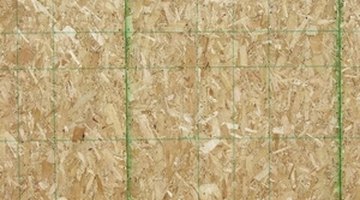Alternatives to Plywood
Plywood sheathing is used in house construction projects for subflooring and roofing. It's made of multiple layers of veener glued together; the more layers which are present in a plywood sheath, the stronger the sheet is. Plywood is fairly inexpensive, resists damage caused by expansion and contraction, and helps shore up and stabilize the frame of a new construction, though there are a number of alternative sheathings which possess their own benefits.
Fiberboard

Fiberboard is made by mixing wood and other plant fibers with binding agents and compressing them into a sheet. Increasingly, fiberboard products are being made with post-consumer recycled fibers.
Fiberboard is also known as blackboard or grayboard, and is used as an insulative construction casing. As with plywood, fiberboard is used for wall sheathing and floors, and is used for both structural and nonstructural purposes.
Benefits of fiberboard are threefold: It has higher insulative properties than plywood, is more effective at sound reduction, and is the cheapest of the plywood alternatives.
Cement Board
Cement boards are panels created by combining Portland cement with fiberglass mesh material for reinforcement. These boards are most often used for floor work, specifically as a base for ceramic tile installation. Occasionally, they are also used for sheathing on the outside of a home or building, particularly structures which are to be coated with stucco. Because cement board doesn't offer structural integrity to a construction, buildings which have been encased with cement board require corner bracing.
Gypsum Board
Gypsum is a soft white or gray mineral made of hydrated calcium sulfate, and has been used in the building industry for many years. Gypsum panels have traditionally been compressed sheaths of gypsum encased in paper, though there are numerous types of gypsum panels, including gypsum core with glass mat facing and a hybrid of gypsum, cellulose and perlite with waterproof facing.
Like cement board, gypsum panels are used under stucco finishing as well as brick face.
Foil- or Paper-Faced Insulative Board
This type of insulative board is a very thin but strong sheathing panel with a thickness range of 0.078 to 0.137 inches. Despite the thinness of foil or paper-faced insulative board, this type of sheathing is considered structural, rendering corner bracing unnecessary. Another attractive feature of these panels is the ability to use sheaths that are much larger than some plywood sheaths, with some foil- or paper-faced insulative boards manufactured in sizes up to 80 inches by 16 feet.
Foam Sheathing
Of all the varieties of alternative sheathing, foam sheathing is the most insulative. Each subvariety of foam sheathing has a different insulation rating, known as an R-value, which correlates with the formulation and thickness of the foam panel.
This type of sheathing is often made from extruded or expanded polystyrene, and polyisocyanurate. Because it is not considered structural, foam sheathing requires corner bracing.
References
Writer Bio
Juan Ramirez has been a writer for over 14 years and worked for two years as an assistant editor with an internationally circulated journal. Ramirez holds a Bachelor of Arts in English writing from Potsdam State University and a Master of Arts in individualized study from New York University.
Photo Credits
- plywood texture image by jimcox40 from Fotolia.com
More Articles



